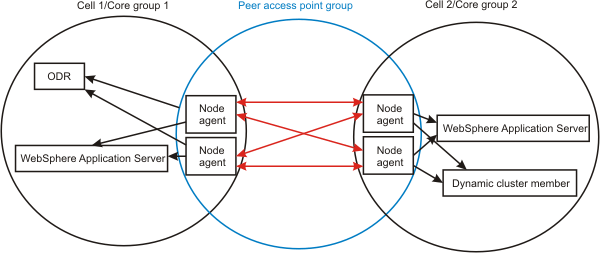Configure WebSphere Virtual Enterprise for cross-cell communication
You can enable cross-cell communication when a WebSphere® Virtual Enterprise administrative cell contains servers that are enabled with on demand router (ODR) that routes to other WebSphere Application Server administrative cells.
Before you begin
Configure the cells that need to communicate with each other and create the on demand router.
About this task
When the ODR needs to route work to servers that are in different cells, you can configure cross-cell communication by creating a core group bridge.You must use the crossCellCGBCfg command to configure WebSphere Virtual Enterprise cells to communicate. Do not create a core group bridge in the administrative console. The crossCellCGBCfg command performs the following configuration actions:
- Enables the core group bridge service between the cell that is running the ODR and another WebSphere Application Server administrative cell.
- Configures core group bridges on all of the node agents in both cells.
- Enables the WebSphere Virtual Enterprise overlay communication function between the cells.
Procedure
- Start enough of the processes in each cell to capture all the nodes to participate in cross-cell communication, including the deployment manager and node agents.
- Verify that the XD-CGB-EXPORT file is created for each cell. The XD-CGB-EXPORT file is in the install_root/profiles/deployment_manager_profile_name/config/cells/cell_name directory. If you are using a firewall, verify that the firewall is open for the ports that are listed in the XD-CGB-EXPORT file to support communication.
- Verify that the overlaynodes.config file is created for each cell. The overlaynodes.config file is in theinstall_root/profiles/deployment_manager_profile_name/config/cells/cell_name directory. If you are using a firewall, verify that the firewall is open for the ports that are listed in the overlaynodes.config file to support communication.
- Run the crossCellCGBCfg command in each cell.
- From a command prompt, type the following command against the
ODR deployment manager process for each back-end cell to which the ODR cell
routes:
crossCellCGBCfg create dmgr_host deployment_manager_SOAP_port path_to_external_cell_XD-CGB-EXPORT path_to_external_cell_overlaynodes.config_file
When security is enabled for the crossCellCGBCfg command, include the user ID and password as additional parameters: crossCellCGBCfg create dmgr_host deployment_manager_SOAP_port path_to_external_cell_XD-CGB-EXPORT path_to_external_cell_overlaynodes.config_file user_name password
This command identifies to the ODR the external cell that is represented by the XD-CGB-EXPORT and overlaynodes.config files. The XD-CGB-EXPORT file is a subset of the serverindex.xml file that isolates the required endpoints for cross-cell high availability manager communication in a runtime environment. If you examine the contents of the serverindex.xml file directly or by way of the endpoint manager for a node agent in the administrative console, the endpoint that is used by the cross cell function is P2P_CGBS_UNICAST_ADDRESS. Any firewall that is employed between the ODR cell and the back-end cell needs to allow the traffic to flow through the ports that are represented by this endpoint on each node in the ODR and back-end cells.
- Run the crossCellCGBCfg command on each back-end cell, against the deployment manager process of that cell, to import the XD-CGB-EXPORT and overlaynodes.config files of the ODR cell. Importing the files between two back-end cells is not supported.
- From a command prompt, type the following command against the
ODR deployment manager process for each back-end cell to which the ODR cell
routes:
- Enabling communication between cells that have security enabled
If the cells that you are using for cross-cell communication have some form of security enabled, such as LDAP (LDAP) administration security, set up communication between the cells.
- Stop all of the processes in each cell.
- Restart each cell.
Results
The on demand router routes work to servers that are in different cells.
Example
Figure 1. Cross-cell communication topology diagram. This topology shows the logical division between two cells where each cell is running several servers. Each node agent runs a peer access point bridge between the cells, making the bridges part of a peer access point group.
What to do next
If you want to clear previous imports and start over, run the following command:crossCellCGBCfg clear dmgr_host deployment_manager_SOAP_portOr, if you want to the cross cell communication to use Secure Sockets Layer (SSL), set the CGBS_USE_SSL system property to a non-null value on each server in the ODR and backend cells.
Subtopics
Enabling communication between cells that have security enabled
Related concepts
Overview of request flow prioritization
Related tasks
Creating ODRs
Preparing the hosting environment for dynamic operations Creating and configuring ODRs
Creating a new core group
Related reference
coregroupsplit.py script